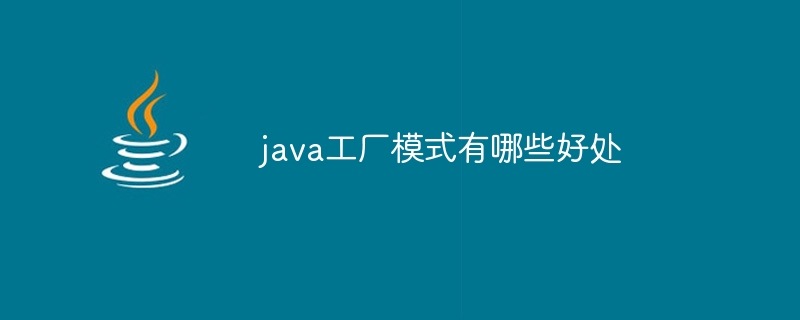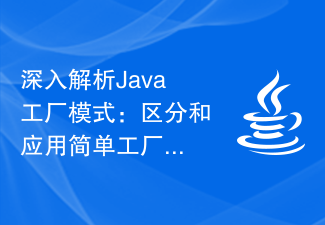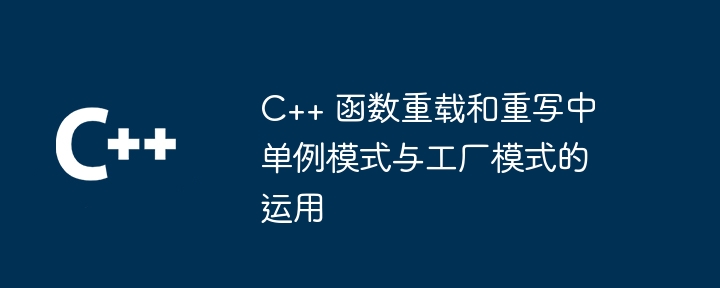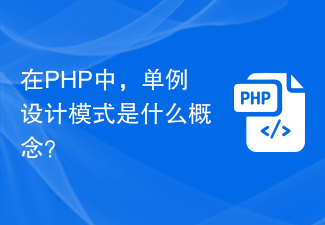 Java
Java javaTutorial
javaTutorial Explore the practical application of Java design patterns: the applicable environments of singleton pattern and factory pattern
Explore the practical application of Java design patterns: the applicable environments of singleton pattern and factory pattern
In-depth understanding of Java design patterns: the application scenarios of singleton mode and factory mode require specific code examples
Design patterns are practiced and widely used in software development Methodology and experience summary for solving specific problems. In Java language application development, commonly used design patterns include singleton pattern and factory pattern. This article will deeply explore the application scenarios of these two design patterns and illustrate them with specific code examples.
1. Singleton pattern
The singleton pattern is a commonly used creational design pattern. It ensures that a class has only one instance and provides a global access point. Specific implementation methods include lazy man style and hungry man style.
The lazy singleton mode is suitable for situations where resources are relatively large and frequently used. The following is a sample code of the lazy singleton pattern:
public class LazySingleton {
private static LazySingleton instance;
private LazySingleton() {
// 私有构造方法
}
public static LazySingleton getInstance() {
if (instance == null) {
synchronized (LazySingleton.class) {
if (instance == null) {
instance = new LazySingleton();
}
}
}
return instance;
}
}The hungry singleton pattern is suitable for situations where resources are relatively small and will always be used. The following is a sample code of the Hungry-style singleton pattern:
public class EagerSingleton {
private static final EagerSingleton instance = new EagerSingleton();
private EagerSingleton() {
// 私有构造方法
}
public static EagerSingleton getInstance() {
return instance;
}
}The application scenarios of the singleton pattern include but are not limited to the following situations:
- Objects that need to be created and destroyed frequently, To reduce resource usage;
- Objects that require global access to facilitate sharing data or calling methods between different modules;
- Need to control the number of instances of classes, such as thread pools and database connection pools wait.
2. Factory pattern
Factory pattern is a commonly used creational design pattern. It encapsulates the object creation process in a factory class and provides a unified interface to the outside world. . Factory patterns include ordinary factory pattern, factory method pattern and abstract factory pattern.
Ordinary factory mode is suitable for dynamically deciding which specific instance to create based on the incoming parameters. The following is a sample code of a common factory pattern:
public class ShapeFactory {
public Shape createShape(String shapeType) {
if ("circle".equals(shapeType)) {
return new Circle();
} else if ("rectangle".equals(shapeType)) {
return new Rectangle();
} else if ("triangle".equals(shapeType)) {
return new Triangle();
} else {
return null;
}
}
}The factory method pattern is suitable for situations where the product line needs to be expanded. Each specific factory is responsible for creating a product. The following is a sample code of the factory method pattern:
public interface ShapeFactory {
Shape createShape();
}
public class CircleFactory implements ShapeFactory {
@Override
public Shape createShape() {
return new Circle();
}
}
public class RectangleFactory implements ShapeFactory {
@Override
public Shape createShape() {
return new Rectangle();
}
}
public class TriangleFactory implements ShapeFactory {
@Override
public Shape createShape() {
return new Triangle();
}
}The abstract factory pattern is suitable for situations where you need to create a set of related or dependent product objects. The following is a sample code of the abstract factory pattern:
public interface AbstractFactory {
Shape createShape();
Color createColor();
}
public class CircleFactory implements AbstractFactory {
@Override
public Shape createShape() {
return new Circle();
}
@Override
public Color createColor() {
return new Red();
}
}
public class RectangleFactory implements AbstractFactory {
@Override
public Shape createShape() {
return new Rectangle();
}
@Override
public Color createColor() {
return new Blue();
}
}
public class TriangleFactory implements AbstractFactory {
@Override
public Shape createShape() {
return new Triangle();
}
@Override
public Color createColor() {
return new Green();
}
}Application scenarios of the factory pattern include but are not limited to the following situations:
- Situations where multiple similar objects need to be created to simplify the code Logic;
- Need to hide the creation details of specific products to reduce coupling;
- Need to expand the product line to facilitate the creation of new products.
To sum up, the singleton pattern and factory pattern are commonly used design patterns and are widely used in Java application development. The singleton pattern is suitable for scenarios where it is necessary to ensure that a class has only one instance, while the factory pattern is suitable for scenarios where the creation process of an object needs to be encapsulated. In specific applications, developers should choose appropriate design patterns based on needs to improve code quality and maintainability.
The above is the detailed content of Explore the practical application of Java design patterns: the applicable environments of singleton pattern and factory pattern. For more information, please follow other related articles on the PHP Chinese website!
 一文理解JavaScript中的单例模式Apr 25, 2023 pm 07:53 PM
一文理解JavaScript中的单例模式Apr 25, 2023 pm 07:53 PMJS 单例模式是一种常用的设计模式,它可以保证一个类只有一个实例。这种模式主要用于管理全局变量,避免命名冲突和重复加载,同时也可以减少内存占用,提高代码的可维护性和可扩展性。
 java工厂模式有哪些好处Dec 25, 2023 pm 05:40 PM
java工厂模式有哪些好处Dec 25, 2023 pm 05:40 PMjava工厂模式的好处:1、降低系统的耦合度;2、提高代码的复用性;3、隐藏对象的创建过程;4、简化对象的创建过程;5、支持依赖注入;6、提供更好的性能;7、增强可测试性;8、支持国际化;9、促进开放封闭原则;10、提供更好的扩展性。详细介绍:1、降低系统的耦合度,工厂模式通过将对象的创建过程集中到一个工厂类中,降低了系统的耦合度;2、提高代码的复用性等等。
 深入解析Java工厂模式:区分和应用简单工厂、工厂方法和抽象工厂的不同Dec 28, 2023 pm 03:09 PM
深入解析Java工厂模式:区分和应用简单工厂、工厂方法和抽象工厂的不同Dec 28, 2023 pm 03:09 PMJava工厂模式详解:理解简单工厂、工厂方法和抽象工厂的区别与应用场景引言在软件开发过程中,面对复杂的对象创建和初始化过程,我们往往需要使用工厂模式来解决这一问题。Java作为一种常用的面向对象编程语言,提供了多种工厂模式的实现方式。本文将详细介绍Java工厂模式的三种常见实现方式:简单工厂、工厂方法和抽象工厂,并且对它们的区别以及应用场景进行深入分析。一、
 C++ 函数重载和重写中单例模式与工厂模式的运用Apr 19, 2024 pm 05:06 PM
C++ 函数重载和重写中单例模式与工厂模式的运用Apr 19, 2024 pm 05:06 PM单例模式:通过函数重载提供不同参数的单例实例。工厂模式:通过函数重写创建不同类型的对象,实现创建过程与具体产品类的解耦。
 Java工厂模式详解:简单工厂、工厂方法和抽象工厂Dec 28, 2023 am 10:23 AM
Java工厂模式详解:简单工厂、工厂方法和抽象工厂Dec 28, 2023 am 10:23 AMJava工厂模式详解:简单工厂、工厂方法和抽象工厂工厂模式是一种常用的设计模式,它用于根据不同的需求动态创建对象,将对象的创建与使用分离,提高代码的可复用性和可扩展性。在Java中,工厂模式主要有三种形式:简单工厂、工厂方法和抽象工厂。一、简单工厂模式简单工厂模式是最基本的工厂模式,也是最简单的一种形式。它通过一个工厂类来创建对象,根据不同的参数来决定创建哪
 PHP入门指南:单例模式May 20, 2023 am 08:13 AM
PHP入门指南:单例模式May 20, 2023 am 08:13 AM在软件开发中,常常遇到多个对象需要访问同一个资源的情况。为了避免资源冲突以及提高程序的效率,我们可以使用设计模式。其中,单例模式是一种常用的创建对象的方式,即保证一个类只有一个实例,并提供全局访问。本文将为大家介绍如何使用PHP实现单例模式,并提供一些最佳实践的建议。一、什么是单例模式单例模式是一种常用的创建对象的方式,它的特点是保证一个类只有一个实例,并提
 理解PHP面向对象编程中的工厂模式Aug 10, 2023 am 10:37 AM
理解PHP面向对象编程中的工厂模式Aug 10, 2023 am 10:37 AM理解PHP面向对象编程中的工厂模式工厂模式是一种常用的设计模式,它用于创建对象的过程中将对象的创建和使用解耦。在PHP面向对象编程中,工厂模式可以帮助我们更好地管理对象的创建和生命周期。本文将通过代码示例来详细介绍PHP中的工厂模式。在PHP中,我们可以通过使用工厂模式来实现对象的创建和初始化过程,而不是直接使用new关键字。这样做的好处是,如果将来需要改变
 在PHP中,单例设计模式是什么概念?Aug 18, 2023 pm 02:25 PM
在PHP中,单例设计模式是什么概念?Aug 18, 2023 pm 02:25 PMSingleton模式确保一个类只有一个实例,并提供了一个全局的访问点。它确保在应用程序中只有一个对象可用,并处于受控状态。Singleton模式提供了一种访问其唯一对象的方式,可以直接访问,而无需实例化类的对象。示例<?php classdatabase{ publicstatic$connection; privatefunc


Hot AI Tools

Undresser.AI Undress
AI-powered app for creating realistic nude photos

AI Clothes Remover
Online AI tool for removing clothes from photos.

Undress AI Tool
Undress images for free

Clothoff.io
AI clothes remover

AI Hentai Generator
Generate AI Hentai for free.

Hot Article

Hot Tools

SublimeText3 English version
Recommended: Win version, supports code prompts!

VSCode Windows 64-bit Download
A free and powerful IDE editor launched by Microsoft

MantisBT
Mantis is an easy-to-deploy web-based defect tracking tool designed to aid in product defect tracking. It requires PHP, MySQL and a web server. Check out our demo and hosting services.

WebStorm Mac version
Useful JavaScript development tools

EditPlus Chinese cracked version
Small size, syntax highlighting, does not support code prompt function





